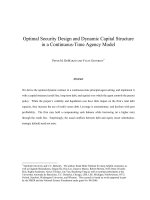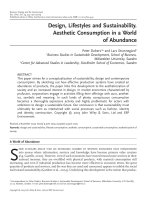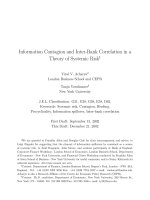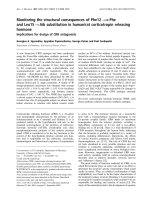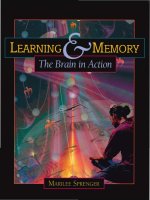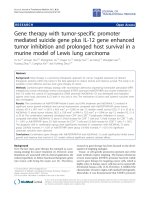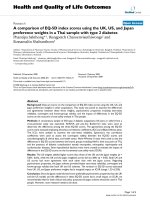Application of deep learning and random forest algorithms in a machine learning-based well log analysis for a small data set of a sand zone
Bạn đang xem bản rút gọn của tài liệu. Xem và tải ngay bản đầy đủ của tài liệu tại đây (1.95 MB, 11 trang )
PETROLEUM EXPLORATION & PRODUCTION
PETROVIETNAM JOURNAL
Volume 6/2020, pp. 4 - 14
ISSN 2615-9902
APPLICATION OF DEEP LEARNING AND RANDOM FOREST
ALGORITHMS IN A MACHINE LEARNING-BASED WELL LOG
ANALYSIS FOR A SMALL DATA SET OF A SAND ZONE
Ruwantha Ratnayake1, Pham Huy Giao1,2
1
Asian Institute of Technology (AIT)
2
Vietnam Petroleum Institute (VPI)
Email: /
Summary
Artificial intelligence (AI) and machine learning (ML) have the potential to reshape the oil and gas exploration and production
landscape. Once viewed as a promising novelty, AI and ML are not far away from becoming mainstream for all exploration and production
companies. Earlier many researchers have worked on using intelligent analyses such as Artificial Neural Network (ANN), deep learning
(DL), Fuzzy, Genetic Algorithm (GA) in well log interpretation, which are supposed to be effective for large data sets. Random forest (RF)
algorithm so far has not been much applied for well log analysis. In this research, a code in Python language was developed for DL and
RF analyses for well log interpretation. To highlight the advantages of the RF-based well log analysis we applied the new code for a small
data set over a 50 m depth zone consisting of clay and sand zones.
Porosity, permeability and water saturation of the reservoir zone were predicted by the RF analysis, compared with those obtained
by the DL analysis and validated with the core measurements. It was found that there is a significant improvement in the analysis running
time and the accuracy of the RF-predicted well log answers compared to those results by DL analysis. It is therefore recommended that
more applications of RF-based well log analysis be done for clastic reservoirs in Vietnam in the future.
Key words: Machine learning (ML), Python, random forest (RF), well log analysis, sand reservoir.
1. Introduction
RF is a classifier that evolves from decision trees. To
classify a new instance, each decision tree provides a
classification for input data; RF collects the classifications
and chooses the most voted prediction as the result. The
input of each tree is sampled data from the original dataset.
In addition, a subset of features is randomly selected from
the optional features to grow the tree at each node. Each
tree is grown without pruning. Essentially, RF enables a
large number of weak or weakly-correlated classifiers to
form a strong classifier.
The RF algorithm is composed of different decision
trees, each with the same nodes, but using different data
that leads to different leaves. It merges the decisions
of multiple decision trees in order to find an answer,
which represents the average of all these decision trees.
Date of receipt: 22/11/2019. Date of review and editing: 22/11 - 24/12/2019.
Date of approval: 5/6/2020.
4
PETROVIETNAM - JOURNAL VOL 6/2020
The RF algorithm is a supervised learning model, it uses
labelled data to “learn” how to classify unlabelled data.
The RF algorithm is used to solve both regression and
classification problems, making it a diverse model that is
widely used by engineers [1].
1.1. Earlier developments to RF
Ho proposed a method to overcome a fundamental
limitation on the complexity of decision tree classifiers
derived with traditional methods [2]. Such classifiers
cannot grow to arbitrary complexity without sacrificing
the generalisation accuracy on unseen data. The proposed
method uses oblique decision trees which are convenient
for optimising training set accuracy. The essence of the
method is to build multiple trees in randomly selected
subspaces of the feature space. The trees generalise their
classification in complementary ways, and their combined
classification can be monotonically improved.
Amit and Geman proposed a shape recognition
approach based on the joint induction of shape features
PETROVIETNAM
and tree classifiers [3]. Because of virtually infinite number
of features, they reached the conclusion that no classifier
based on the full feature set could be evaluated as it was
impossible to determine a priori whose features were
informative. Due to the number and nature of features,
standard decision tree construction based on a fixed
length feature vector was not feasible. An alternative
approach would be to entertain a small random of
sample features at each node, constrain their complexity
to increase with tree depth, and grow multiple trees.
Terminal nodes contain estimates of the corresponding
posterior distribution over shape classes. By sending the
image down and aggregating the resulting distribution,
the image can be classified.
In another paper by Ho [4], he proposed a method
to solve the dilemma between overfitting and achieving
maximum accuracy. This was done by constructing
a decision-tree-based classifier that maintained the
highest accuracy on training data and, at the same
time, improved on generalisation accuracy as it grows
in complexity. The classifier consisted of multiple
trees constructed systematically by pseudo-randomly
selecting subsets of components of the feature vector,
that is, trees constructed in randomly chosen subspaces.
When empirically tested against publicly available data
sets, the subspace method proved its superiority when
compared to single-tree classifiers and other forest
construction methods. The next section introduces RF
which is an ensemble method that combines existing
techniques in order to construct a collection of decision
trees with controlled variation.
1.2. RF algorithm
RF is an ensemble learning method used for
classification and regression. Developed by Breiman
[5], the method combines Breiman’s bagging sampling
approach [6] and the random selection of features,
introduced independently by Ho [2, 4] and Amit and
Geman. [3], in order to construct a collection of decision
trees with controlled variation. Using bagging, each
decision tree in the ensemble is constructed using a sample
with replacement from the training data. Statistically, the
sample is likely to have about 64% of instances appearing
at least once in the sample. Instances in the sample are
referred to as in-bag instances, and the remaining instances
(about 36%) are referred to as out-of-bag instances. Each
tree in the ensemble acts as a base classifier to determine
the class label of an unlabelled instance. This is done via
majority voting where each classifier casts one vote for its
predicted class label, then the class label with the most
votes is used to classify the instance.
Decision tree: Figure 1 shows a schematic decision tree
that is a structure used in decision making process. This
structure starts with a root node, which then branches to
another decision node, repeating this process until a leaf
is reached. A node asks a question in order to help classify
the data. A branch represents the different possibilities
that this node could lead to.
Some of the basic terminology related to decision
trees are given below:
Root node: It represents entire population or
sample and this further gets divided into two or more
homogeneous sets.
Splitting: It is a process of dividing a node into two or
more sub-nodes.
Decision node: When a sub-node splits into further
sub-nodes, then it is called decision node.
Leaf node: Node which does not split is called leaf or
terminal node.
Pruning: When a sub-node of a decision node is
removed, this process is called pruning. It is the opposite
process of splitting.
Branch/Sub-tree: A sub section of an entire tree is
called branch or sub-tree.
Parent and Child node: A node, which is divided into
sub-nodes is called parent node of sub-nodes whereas
sub-nodes are the child of parent node.
Splitting decision trees: Breiman. [5] introduced
additional randomness during the construction of
Root
Node
Branches
Decision
Node
Decision
Node
Branches
Branches
Leaf
Node
Leaf
Node
Leaf
Node
Leaf
Node
Figure 1. Decision tree.
PETROVIETNAM - JOURNAL VOL 6/2020
5
PETROLEUM EXPLORATION & PRODUCTION
decision trees using the classification and regression trees
(CART) technique. Using this technique, the subset of
features selected in each interior node is evaluated with
the Gini index heuristics. The feature with the highest Gini
index is chosen as the split feature in that node. Gini index
has been introduced by Breiman et al. [7]. However, it has
been first introduced by the Italian statistician Corrado
Gini in 1912. The index is a function that is used to measure
the impurity of data, i.e. the uncertainty of the data. In
classification, this event would be the determination of
the class label [8]. The general form of Gini index is shown
below:
= 1−
( )
(1)
Where: Gini is the Gini index; pi is the probability of
an object being classified=to a (particular
− ) class; c is the
number of unique labels.
needs to be done. The data does not need to be rescaled
or transformed.
- Parallelable: They are parallelisable, meaning that
we can split the process to multiple machines to run. This
results in faster computation time. Boosted models are
sequential in contrast and would take longer to compute.
- Quick prediction/training speed: It is faster to train
than decision trees because we are working only on a
subset of features in this model, so we can easily work
with hundreds of features. Prediction speed is significantly
faster than training speed because we can save generated
forests for future uses.
- Handles unbalanced data: RF methods for
balancing error in class population unbalanced data sets.
RF tries to minimise the overall error rate, so when we have
an unbalanced data set, the larger class will get a low error
rate while the smaller class will have a larger error rate.
Breiman [5] showed that the RF error rate depends
on correlation and strength. Increasing the correlation
= the( RF−increases
)
between any two trees in
the forest
error rate. A tree with a low error rate is a strong classifier.
Increasing the strength of the individual trees decreases
the RF error rate. Such findings=seem to be consistent with
a study made by Bernard et al. [9], which showed that the
error rate statistically decreases by jointly maximising the
strength and minimising the correlation.
- Low bias, moderate variance: Each decision tree
has a high variance, but low bias. However, because we
average all the trees in RF, we are averaging the variance
as well so that we have a low bias and moderate variance
model [1].
1.3. Advantages of RF
Banking sector: The banking sector consists of most
users. There are many loyal customers and also fraud
customers. RF analysis can be used to determine whether
the customer is a loyal or a fraud. A system uses a set of
RF, which identifies the fraud transactions by a series of
the pattern.
Key advantages of RF are robustness to noise and
overfitting [5, 10]. Overfitting generally occurs when a
model is constructed in such a way that it fits the data
more than it is warranted. A model which has been overfit
will generally have poor predictive performance, as it does
not generalise well. By generalisation we mean how well
the model will make predictions for cases that are not in
the training set. Hawkins pointed out that overfitting adds
complexity to a model without any gain in performance
or, even worse, leads to poorer performance [11]. A
classifier that suffers from overfitting is likely to have a low
error rate for the training instances (in-bag instances), and
a higher error rate for the out-of-bag instances.
Other advantages of RF can be listed as follows:
- High versatility: Whether the task is regression or
classification, RF is an applicable model for all the needs.
It can handle binary features, categorical features, and
numerical features. There is very little pre-processing that
6
PETROVIETNAM - JOURNAL VOL 6/2020
1.4. General applications of RF algorithm
There are several sectors where the RF can be applied
as listed below:
Medicines: Medicines needs a complex combination
of specific chemicals. Thus, to identify the great
combination in the medicines, RF can be used. With the
help of machine learning algorithm, it has become easier
to detect and predict the drug sensitivity of a medicine.
Also, it helps to identify the patient’s disease by analysing
the patient’s medical record.
Stock market: Machine learning also plays role in
the stock market analysis. When it is needed to know
the behaviour of the stock market, with the help of RF
algorithm, the behaviour of the stock market can be
analysed. Also, it can show the expected loss or profit which
can be produced while purchasing a particular stock.
PETROVIETNAM
Applications of RF algorithm in oil & gas: In a research
done by Chen, he successfully applied ML methods to
predict well productivity and design hydraulic fracturing
parameters in Montney and Duvernay Formations. He
found out that ensemble models such as RF and ExBoost
seem to outperform other types of ML methods (SVM,
ANN) with a higher prediction accuracy [12].
1.5. Grid search method in ML
Grid search is the process of performing hyper
parameter tuning in order to determine the optimum
values for a given model. This is significant as the
performance of the entire model is based on the hyper
parameter values specified. ‘GridSearchCV’ in the sklearn
library of Python is a method which calculates a score
for different hyper parameter combinations based on
accuracy (R2 score), network building time and running
= 11−− ( ( ) )
time of the module.=The
combination which has the R2
( optimum
)
=
1
−
highest score is selected as the
combination.
2
The R score is calculated by Equations (2 - 4).
==
( ( −− ) )
( − )
=
==
(2)
( ( −− ) )
( − )
=
(3)
(4)
==
=
Where: SST is the total variation in the data (sum of
squared total), SSR is the sum of squares regression, yi is
the y value for observation i, is the mean of y values and
is the predicted values of y for observation I, and R2 is
the correlation coefficient.
1.6. Transfer functions
Transfer function is an algorithm process to transfer
weighted sum to the hidden layers and the output layer.
The transfer function is chosen to satisfy some specification
of the problem that neural network is attempting to solve.
2. Methodology
The general workflow adopted in this study is
explained in Figure 2.
2.1. Data collection and preparing the training input
data
The published data set used in this study is taken from
Darling [13] for a clastic reservoir located from 616 to 675
m deep. The well log data consist of gamma ray (GR), deep
resistivity (LLD), sonic (DT), density (RHOB), and neutron
porosity (NPHI). A part of the well data from 616 to 631 m
was used as training data, while the part of well log data
from 631 to 675 m was used for prediction. The target
effective porosity (Φe) was calculated based on density
(ΦD) and neutron (ΦN) porosity as shown in Equations (5)
and (6) [14]:
Table 1. Common transfer functions used in neural networks (ANN and DL analyses)
Activation function
Equation
Derivative
Linear
( )=
′( ) = 1
Unit step (Heaviside
function)
Sign (Signum)
0,
( ) = 0.5,
1,
< 0
= 0
> 0
′( ) = 0
− 1,
0,
1,
< 0
= 0
> 0
′( ) = 0
( )=
Logistic (Sigmoid)
( )=
Hyperbolic tangent (tanh)
( )=
ReLu
( )=
1
′( ) =
1+
−
+
0,
,
( )(1 −
′( ) = 1 −
< 0
> 0
′( ) =
0,
1,
1D graph
( ))
( )
< 0
> 0
PETROVIETNAM - JOURNAL VOL 6/2020
7
PETROLEUM EXPLORATION & PRODUCTION
Start
Well log data collection [13]
Develop the DL module
using Python
Develop the RF module
using Python
WL interpretation and
preparation of training data
Run machine learning analysis (DL & RF) and compare
the results
Figure 2. Workflow of the study.
Table 2. Well log-calculated and core petrophysical parameters
Depth (m)
Porosity
Calculated
0.03
0.022
0.11
0.014
0.091
0.16
0.13
0.1
0.08
0.04
0.16
0.155
Core
0.02
0.02
0.1105
0.01
0.095
0.156
0.15
0.075
0.105
0.06
0.179
0.156
620.116
622.097
624.078
626.059
628.040
630.022
632.003
634.136
636.118
638.099
640.080
642.061
=
=
−
−
−
−
Permeability (mD)
Core
Calculated
0.01
0.11
0.02
0.05
22
10.1
0.03
0.029
10.5
7.12
135.6
201.12
120
68.45
11
8.27
15.3
5.42
0.8
0.16
350
482.71
130
218.9
Water saturation
Calculated
1.0
1.0
0.042
0.74
0.036
0.018
0.022
0.035
0.04
1.0
0.025
0.046
(5)
+
(6)
+
2
2
Where: ρm is the matrix density (g/cc) and is equal to
2.65 g/cc in this case for sandstone, ρ is bulk density (g/
−
cc), ρf is=fluid density (g/cc), ΦD is density porosity, ΦN is
−
×
5×
0.4 ×
neutron porosity and=Φe 0.4
is effective
×
×
+ 5×
× porosity.
×
×
=
+ ×
×
×
The water+ saturation of training data set was
=
∗ (1963)’s
)
calculated using
method as shown in
2 Simandoux
= 10((
∗ )
=
10
Equation (7). Simandoux equation was used because the
zone of analysis includes shaly sand intervals.
=
=
=
0.4 ×
×
×
+
5×
×
×
−
(7)
(
∗ Φ
) is effective porosity, Rw is resistivity of
= 10Where:
water, Vsh is shale volume, Rt is formation resistivity, Rsh
is resistivity of shale, a is an empirical constant and m is
cementation exponent.
8
PETROVIETNAM - JOURNAL VOL 6/2020
−
−
Figure 3. Calculated petrophysical parameters vs core values.
To determine permeability a poro-perm relationship
was developed based on Equation (8) using the core data.
k = 10(k
a
+ k b × Φe )
(8)
Using core porosity and permeability values ka and
kb were determined as -2 and 28.04 respectively. The core
PETROVIETNAM
measurements for this case study are represented in Table 2. The calculated
petrophysical parameters as mentioned above are plotted versus the core
values in Figure 3 that show a very good match.
2.2. Developing the DL module
DL could be usefully applied in well log analysis as indicated in a
research by Giao and Sandunil [15]. Figure 4 shows the architecture of
the DL network used in this study, which has three main layers, namely,
input layer, hidden layer(s) and output layer. Input values of each hidden
layer is multiplied by a certain weight and the summation is introduced
to a transfer function assigned to each neuron. Training of an DL network
is done using training examples. Grid search method which is an inbuilt
function of sklearn library was used to find out the optimum hyper
parameters for this data set. In this a total of 960 combinations were
tested by varying the number of hidden layers from 1 to 50, neurons from
5 to 100, learning rate from 0.0001 to 0.1 and the transfer function being
linear, unit step, sign, Sigmoid, tanh and Relu. Table 3 shows the best
combination of hyper parameters which had the highest score that was
used in DL code.
Table 3. The best combination of hyper parameters
Hyper parameter
Gridsearch R2 score
Number of hidden layers
Neurons per hidden layer
Learning rate
Number of iterations
Activation function
Result
0.952
50
100
0.0001
1000
ReLu
Figure 4. Architecture of the DL network employed in this study.
Import
machine
learning
libraries and
training data
Split the
imported data
into training,
testing,
validation and
Build
multiple
decision
trees using
the training
2.3. Developing the RF module
The RF module was developed with
multiple number of decision trees and
also coded in Python programming
language as explained in Section 2.4. The
flowchart of the Python code is shown
in Figure 5. Normally in RF, the accuracy
of the predicted results changes with
the number of decision trees used.
Therefore, in this case the trial and error
method was used to find the optimum
number of decision trees to get the most
accurate results.
2.4. Coding and running the DL and RF
modules in Python language
Python programming language
was used in developing both the
modules due to its ease to learn and the
availability of vast amount of machine
learning libraries. Number of standard
libraries were used as shown in Table 4
in developing the codes.
An illustration of the Python codes
for DL and RF analysis is shown in Tables
5 & 6. The Python package manager
used in this study was Anaconda.
Anaconda is a free and open-source
distribution of the Python programming
language for scientific computing (data
science, machine learning applications,
large-scale data processing, predictive
analytics, etc.), that aims to simplify
package management and deployment.
In order to create the code Jupyter
Notebook was used [16], which is an
open-source web application that
allows to create and share documents
that contain live code, equations,
visualisations and narrative text.
Import the
target data set
and predict
well log results
using trained
Compute the
R2 score
between
predicted and
actual well log
Figure 5. Flowchart of the Python code created for RF module.
PETROVIETNAM - JOURNAL VOL 6/2020
9
PETROLEUM EXPLORATION & PRODUCTION
Table 4. Libraries used in the code
Module
DL
RF
Library
Pandas
Matplotlib
Keras
Sklearn
Pandas
Matplotlib
Sklearn
Purpose
Import training and predicting data sets
Plotting the final interpretation plots
Building the neural network with desired hyper parameters
Splitting and scaling the training data, calculating the R2 score
Import training and predicting data sets
Plotting the final interpretation plots
Scale the training data and building random decision trees by using training data set
Table 5. Structure of Python codes for DL module
Task
Python code
Importing libraries
Building the neural network
Training the network
Testing and validating the network
Running the module for predicting data set and
saving the output
Table 6. Structure of Python codes for RF module
Task
Importing libraries
Splitting the data into training, testing
and validation
Creating decision trees
Training phase
Testing, validating phase
Running the module for predicting data
set and saving the output
10
PETROVIETNAM - JOURNAL VOL 6/2020
Python code
PETROVIETNAM
Figure 6. Well log curves [13].
Table 7. Log responses and answers interpreted for the zoned layers at the study location [13]
Zone Lithology
01
02
03
04
05
Shale
Sand
Shale
Sand
Shaly sand
Log Responses
Depth
interval
(m)
GR
(API)
RHOB
(g/cc)
PHIN
LLD
(Ω.m)
616-624
624-637
637-639
639-655
655-668
90
35
88
33
74
2.63
2.50
2.60
2.45
2.55
0.07
0.065
0.04
0.09
0.12
11
8
15
2
15
3. Results and discussion
The collected log curves and data, taken from Darling
[13], are shown in Figure 6 and Table 7.
Results from developed Python modules: Analyses
Shale Density
volume porosity
(Vsh )
(ФD)
0.67
0.01
0.17
0.19
0.65
0.10
0.15
0.15
0.52
0.04
Log Answers
Effective
Water
Permeability
porosity Saturation
(mD)
(Фe)
(S w )
0.04
0.85
1.83
0.13
0.05
61.39
0.07
0.08
104.52
0.12
0.18
186.29
0.08
0.65
215.5
for the public data set were done using both DL and RF
modules developed, and the results are presented in
Figures 7 and 8.
As shown in Table 8, the R2 scores were calculated for
each training, testing and predicting phase and compared
PETROVIETNAM - JOURNAL VOL 6/2020
11
PETROLEUM EXPLORATION & PRODUCTION
between two machine learning techniques
that were used in this study, i.e., DL and RF.
It was also observed that the running
time of the RF analysis is significantly lower
compared to that taken by DL module to run
as seen in Table 8 and Figure 9b.
4. Conclusions and recommendations
In this study, two machine learningbased analysis modules, i.e. DL and RF, were
developed using Python programming
language to perform well log analysis. These
two modules were tested on a small size
public data set of a clastic reservoir [9] and
the accuracy of the results was compared. The
following concluding remarks could be drawn:
Figure 7. Results for the DL module.
-- Based on a conventional well log
interpretation on the study data set taken
from Darling [13] a main sand reservoir zone
from 639 to 655 m was identified with an
average effective porosity (ФD+N) of 0.125,
permeability (K) of 123.84 mD, and water
saturation (Sw) of 0.18 that match well with the
core measurements values, i.e. Фcore = 0.13 and
Kcore = 149.24 mD.
Figure 8. Results from RF module.
Table 8. R2 scores for DL and RF modules
Well log
answer
Data set
Porosity
Water
Saturation
Permeability
Average
12
2
R score
DL
RF
Training
0.999
0.997
Testing
0.989
0.984
Predicting
0.904
0.939
Training
0.954
0.989
Testing
0.845
0.980
Predicting
0.754
0.894
Training
0.995
0.994
Testing
0.932
0.975
Predicting
0.786
0.997
0.814
0.943
PETROVIETNAM - JOURNAL VOL 6/2020
Running time
(sec)
DL
RF
91
3
98
5
97
4
95.3
6
-- A number of DL analyses were
conducted by varying the hyper parameters,
i.e. number of hidden layer ranges from 1 to
50, number of neuron per hidden layer varies
from 5 to 100, the learning rate varies from
0.0001 to 0.1, and the transfer function being
linear, unit step, sign, Sigmoid, tanh and ReLu
in both input and output layers. A total of 960
DL analyses have been run, out of which the
best analysis was found to be the one having
50 hidden layers, 100 neurons per hidden layer,
learning rate of 0.0001 and the ReLu transfer
function that gave an average porosity of
0.124, permeability of 112.14 mD and water
saturation of 0.14.
-- Similarly, a number of RF analyses
were run, varying the number of trees from
1 to 10, out of which the analysis with 6 trees
was found the best RF analysis that gave an
average porosity of 0.126, permeability of
122.15 mD and water saturation of 0.19.
-- By comparing the results predicted by
PETROVIETNAM
(a)
(b)
Figure 9. Comparison of (a) R2 score of the predicting phase from two modules, (b) running time of the modules.
DL and RF analyses it was found that those by RF analyses
are better than those predicted by DL analysis (Table 8
and Figure 9a), i.e. better R2 and shorter running time. For
example, the average running time is 6s for RF and 95.3s
for DL, respectively.
-- A notable advantage of RF analysis is that it could
avoid the overfitting problem that is very common for an
ANN or DL analysis. Overfitting can be detected when the
R2 value of the testing is significantly higher than that of
predicting (Table 8).
-- In term of code building, RF algorithm is easier to
be developed in Python than ANN because the RF libraries
are more diverse and a RF analysis requires less number of
hyper parameters to be changed, i.e. only the number of
the trees, while for an ANN or DL analysis more numbers of
hyper parameters have to be tested, i.e. number of hidden
layers, number of neurons per hidden layers, learning rate
range, and type of activation or transfer function.
-- Normally, machine learning-based analysis
requires a big data set to be effective. However, in this
study, the RF algorithm proved that it can be applied for a
small data set, which would increase its applicability and
can be recommended for more applications in well log
analysis.
References
[1] Madision Schott, “Random Forest Algorithm
for machine learning, Part 4 of a Series on Introductory
Machine Learning Algorithms”, 25/4/2019. [Online].
Available: />[2] Tim Kam Ho, “Random decision forests”,
Proceedings of the 3rd International Conference on Document
Analysis and Recognition, 1995.
[3] Yali Amit and Donald Geman, "Shape quantization
and recognition with randomized trees", Neural
Computation, Vol. 9, No. 7, pp. 1545 - 1588, 1997.
[4] Tim Kam Ho, "The random subspace method for
constructing decision forests", IEEE Transactions on Pattern
Analysis and Machine Intelligence, Vol. 20, No. 8, pp. 832 844, 1998.
[5] Leo Beriman, "Random Forests", Machine Learning,
Vol. 45, pp. 5 - 32, 2001.
[6] Leo Breiman, "Bagging predictors", Machine
Learning, Vol. 24, pp. 123 - 140, 1996.
[7] Leo Breiman, Jerome Friedman, R.A.Olshen,
and Charles J.Stone, Classification and regression trees.
Chapman & Hall/CRC, 1984.
PETROVIETNAM - JOURNAL VOL 6/2020
13
PETROLEUM EXPLORATION & PRODUCTION
[8] Mohamed Bader-El-Den and Mohamed Medhat
Gaber, “GARF: Towards self-optimised random forests”,
Proceedings of the 19th International Conference on Neural
Information Processing, pp. 506 - 515, 2012.
[9] Simon Bernard, Laurent Heutte, and Sébastien
Adam, “A study of strength and correlation in random
forests”, Proceedings of the 6th International Conference on
Intelligent Computing, pp. 186 - 191, 2010.
[10] Praveen Boinee, Alessandro De Angelis, and
G.L.Foresti, Meta random forests, International Journal
of Computational Intelligence, Vol. 2, No. 3, pp. 138 - 147,
2005.
[11] Douglas M.Hawkins, The problem of overfitting,
Journal of Chemical Information and Computer Sciences,
Vol. 44: pp. 1 - 12, 2004.
[12] Shengnan Chen, “Application of machine
learning methods to predict well productivity in
14
PETROVIETNAM - JOURNAL VOL 6/2020
Montney and Duvernay”, Training course at SPE Canada
Unconventional Resources Conference, 17 March 2019.
[13] Toby Darling, Well logging and formation
evaluation. Gulf Professional Publishing, 2005.
[14] Pham Huy Giao, “Lecture notes of the CE71.70
course (Petrophysics)”, Asian Institute of Technology,
Bangkok, Thailand, 2018.
[15] Pham Huy Giao and Kushan Sandunil,
Applications of deep learning in predicting the fracture
porosity, Petrovietnam Journal, Vol. 10, pp. 14 - 22, 2017.
[16] Jupyter. [Online]. Available: .
[17] P.Simandoux, "Dielectric measurements in
porous media and application to shaly formation", Revue
de LInstitut Franỗais du Pộtrole, pp. 193 - 215, 1963.
